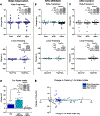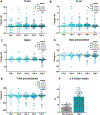Chronic water restriction reduces sensitivity to brain stimulation reward in male and female rats
- PMID: 36740136
- PMCID: PMC10064935
- DOI: 10.1016/j.physbeh.2023.114110
Chronic water restriction reduces sensitivity to brain stimulation reward in male and female rats
Abstract
States of physiological need motivate individuals to seek and consume stimuli that restore homeostatic balance. This goal-directed behavior is driven, in part, by pathways that process reward and are sensitive to changes in physiological state, including the mesolimbic dopamine system. The effects of hunger and its physiological markers have been more widely studied for their role in modulating reward signaling pathways. However, fluid need produces robust goal-directed behavior and has also been shown to affect neural substrates of reward processing. To test how acute and chronic states of thirst might alter reward sensitivity, we used the intracranial self-stimulation (ICSS) rate-frequency paradigm (Carlezon & Chartoff, 2007) with male and female Long Evans rats. We hypothesized that sensitivity to ICSS would increase under an acute need state for water and would decrease under chronic deprivation. We found that acute water deprivation for 22-hours prior to the ICSS session did not alter any parameters of reward sensitivity. To elicit motivated behavior toward water in the absence of physiological need, we chemogenetically activated glutamatergic neurons of the subfornical organ (SFO). Despite eliciting more water consumption than acute deprivation, acute chemogenetic activation of SFO neurons also did not alter reward sensitivity. Finally, subjects underwent a five-day chronic water restriction protocol with daily ICSS sessions to determine the effects of sustained physiological need. Chronic water restriction resulted in reduced sensitivity to ICSS. Together, these results indicate that persistent changes in physiological state alter the responsiveness of reward circuitry that could potentially exacerbate maladaptive reward-seeking behaviors.
Copyright © 2023 Elsevier Inc. All rights reserved.
Figures






References
-
- Blundell JE, & Herberg LJ (1968). Relative Effects of Nutritional Deficit and Deprivation Period on Rate of Electrical Self-stimulation of Lateral Hypothalamus. Nature, 219, 627–628. - PubMed
Publication types
MeSH terms
Substances
Grants and funding
LinkOut - more resources
Full Text Sources

